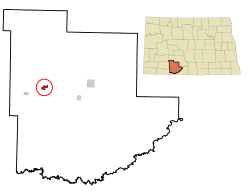Elgin, North Dakota facts for kids
Quick facts for kids
Elgin, North Dakota
|
|
|---|---|

Location of Elgin, North Dakota
|
|
| Country | United States |
| State | North Dakota |
| County | Grant |
| Founded | 1910 |
| Area | |
| • Total | 0.82 sq mi (2.13 km2) |
| • Land | 0.82 sq mi (2.13 km2) |
| • Water | 0.00 sq mi (0.00 km2) |
| Elevation | 2,352 ft (717 m) |
| Population
(2020)
|
|
| • Total | 543 |
| • Estimate
(2022)
|
521 |
| • Density | 659.78/sq mi (254.89/km2) |
| Time zone | UTC-7 (Mountain (MST)) |
| • Summer (DST) | UTC-6 (MDT) |
| ZIP code |
58533
|
| Area code(s) | 701 |
| FIPS code | 38-23020 |
| GNIS feature ID | 1036020 |
Elgin is a city located in Grant County, North Dakota, in the United States. In 2020, about 543 people lived there.
Contents
History of Elgin
Elgin was officially planned out in 1910. This happened when the railroad tracks were extended to reach that area. The town was first called Shanley. However, the Northern Pacific Railroad company thought the name was too much like Stanley, another town nearby. So, the people of Elgin were asked to pick a new name.
During a meeting, one committee member looked at his pocket watch. It was an Elgin brand watch. He suggested "Elgin" as the new name, and everyone agreed! A post office has been open in Elgin since 1910.
On July 4, 1978, a very strong tornado hit Elgin. This powerful storm caused a lot of damage to the town. It was one of the most serious tornadoes ever recorded in North Dakota. The storm even knocked down the town's water tower.
Geography and Climate
Elgin covers an area of about 1.05 square miles (2.72 square kilometers). All of this area is land.
Elgin's Climate
Elgin has a type of weather called a humid continental climate. This means the city experiences big changes in temperature throughout the year. Summers are usually warm to hot, and sometimes humid. Winters are cold, and can sometimes be very cold.
People of Elgin
| Historical population | |||
|---|---|---|---|
| Census | Pop. | %± | |
| 1920 | 429 | — | |
| 1930 | 505 | 17.7% | |
| 1940 | 583 | 15.4% | |
| 1950 | 882 | 51.3% | |
| 1960 | 944 | 7.0% | |
| 1970 | 839 | −11.1% | |
| 1980 | 930 | 10.8% | |
| 1990 | 765 | −17.7% | |
| 2000 | 659 | −13.9% | |
| 2010 | 642 | −2.6% | |
| 2020 | 543 | −15.4% | |
| 2022 (est.) | 521 | −18.8% | |
| U.S. Decennial Census 2020 Census |
|||
Elgin's Population in 2010
In 2010, the city of Elgin had 642 people living there. Most of the people living in Elgin were White (98.3%). A small number were Native American or from other backgrounds.
The average age of people in Elgin was about 57.4 years old. About 17% of the residents were under 18 years old. Many residents, about 35.5%, were 65 years or older. Slightly more than half of the population (54.5%) was female, and 45.5% was male.
Famous Person from Elgin
- Donald D. Lorenzen (1920–1980) was a person who served on the Los Angeles City Council. This is like being part of the city's government.
See also
 In Spanish: Elgin (Dakota del Norte) para niños
In Spanish: Elgin (Dakota del Norte) para niños

